Rite Aid Bundle
Can Rite Aid's Transformation Pave the Way for Future Success?
Rite Aid, a once-dominant force in the pharmacy industry, is at a critical juncture, having weathered significant financial storms and multiple bankruptcy filings. From its humble beginnings in 1962, the company expanded rapidly, but now faces a pivotal moment as it navigates a strategic sale of its assets. This Rite Aid SWOT Analysis delves into the intricacies of its current position.
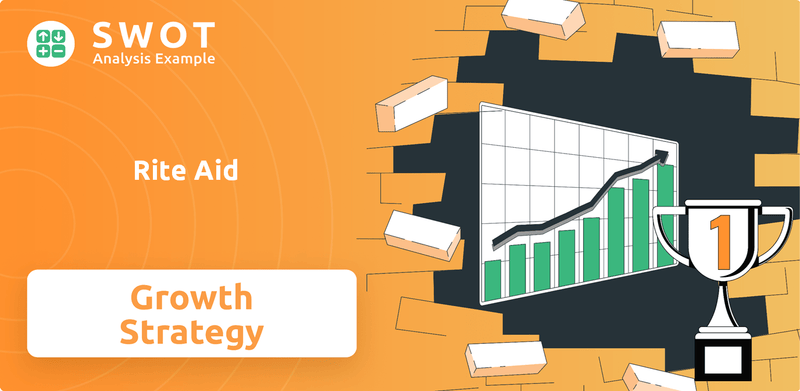
This in-depth analysis explores Rite Aid's Rite Aid growth strategy and evaluates its Rite Aid future prospects amidst a rapidly changing retail and healthcare landscape. We will examine the Rite Aid company analysis, including its Rite Aid business model, Rite Aid market share, and the impact of its Rite Aid financial performance on its ability to compete. Understanding the Rite Aid challenges and opportunities is crucial to assessing the long-term viability of its pharmacy services and healthcare offerings.
How Is Rite Aid Expanding Its Reach?
Historically, the focus of Rite Aid's growth strategy involved expanding its retail pharmacy footprint and diversifying its service offerings. This included strategic acquisitions like the Bartell Drugs chain in late 2020, which added 67 stores for $95 million. However, the company's recent trajectory has shifted dramatically, emphasizing contraction and restructuring rather than expansion.
A significant reduction in store count illustrates this shift. Between 2018 and 2021, Rite Aid operated around 2,500 stores. By early August 2024, the number of stores had decreased to 1,554. As of May 2025, the company had approximately 1,240 stores open, a substantial decrease from the 2,000 stores it operated in 2023. This decline reflects a strategic pivot in the company's approach.
The company's current initiatives are centered on an orderly wind-down and sale of its remaining assets, with stores remaining open to ensure continuity of care during this process. This restructuring is a key element of the company's target market strategy.
Rite Aid's recent bankruptcy filings have accelerated store closures, accompanied by active sales of locations and prescription files. In May 2025, Rite Aid announced agreements to sell prescription files for over 1,000 pharmacy locations to CVS, Walgreens, Albertsons, Kroger, and Giant Eagle. This approach aims to maximize stakeholder value and ensure a smooth transfer of customer prescriptions.
- The sale of the Elixir PBM business to MedImpact Healthcare Systems in February 2024 for $575 million.
- The sale of a portion of its Health Dialog business to Carenet Health in May 2024.
- These divestitures highlight a shift away from traditional expansion towards strategic restructuring.
- The focus is on managing the remaining assets and ensuring continuity of care.
Rite Aid SWOT Analysis
- Complete SWOT Breakdown
- Fully Customizable
- Editable in Excel & Word
- Professional Formatting
- Investor-Ready Format
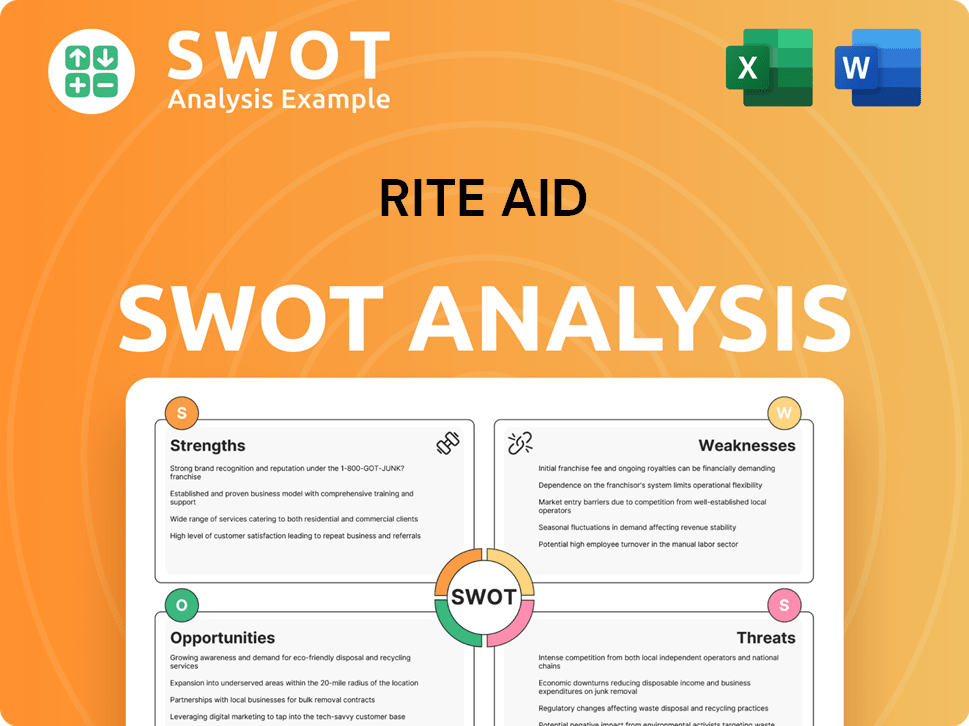
How Does Rite Aid Invest in Innovation?
The innovation and technology strategy of the company has been crucial in its efforts to adapt to changing customer needs and maintain a competitive edge. This strategy focuses on digital transformation, leveraging technology to enhance pharmacy services and improve the overall customer experience. The goal is to meet evolving consumer preferences and streamline operations.
The company's approach includes investments in technology, with initiatives like the 'Endless Aisle' program. This program allows customers to order products not available in-store via a QR code, which are then delivered to them. The company also uses an omnichannel strategy to cater to different customer preferences.
The company has been investing in technology to improve healthcare solutions and operational efficiency. The company's fiscal year 2024 capital expenditures were expected to be approximately $175 million, with a focus on technology, prescription file purchases, and distribution center automation. This reflects a continued commitment to using technology to drive business improvements.
The company is focused on digital transformation to improve pharmacy services. This includes enhancing the customer experience through technology. The goal is to meet the evolving needs of consumers.
The company has adopted an omnichannel approach to cater to evolving consumer preferences. This includes options like in-store pickup for online orders and home delivery. This strategy aims to provide convenience and flexibility to customers.
The company utilizes data from its rewards program to refine product offerings. This data provides insights into customer demographics and preferences. This helps in tailoring marketing strategies.
The company's fiscal year 2024 capital expenditures were expected to be approximately $175 million. These investments focused on technology, prescription file purchases, and distribution center automation. This demonstrates a commitment to improving operations.
The 'Endless Aisle' program allows customers to scan a QR code for products unavailable in-store. These products are then delivered to the customer. This initiative improves convenience and accessibility.
The company has a pilot program to reduce abandoned prescriptions. This initiative aims to improve customer retention. This also improves operational efficiency.
The company's innovation and technology strategy involves several key initiatives and investments aimed at improving its operations and customer experience. These efforts are crucial for the company's Rite Aid growth strategy and future prospects.
- Digital Transformation: The company is focused on digital transformation to enhance pharmacy services. This includes improving the customer experience through technology.
- Omnichannel Strategy: An omnichannel approach is used to cater to evolving consumer preferences. This includes options like in-store pickup and home delivery.
- Data Utilization: The company uses data from its rewards program to refine product offerings and marketing strategies. This provides insights into customer demographics and preferences.
- Capital Expenditures: Fiscal year 2024 capital expenditures were expected to be approximately $175 million. These investments focus on technology, prescription file purchases, and distribution center automation.
- 'Endless Aisle' Program: This program allows customers to scan a QR code for products unavailable in-store, which are then delivered. This improves convenience and accessibility.
- Pilot Program: The company has a pilot program to reduce abandoned prescriptions, aiming to improve customer retention and operational efficiency.
Rite Aid PESTLE Analysis
- Covers All 6 PESTLE Categories
- No Research Needed – Save Hours of Work
- Built by Experts, Trusted by Consultants
- Instant Download, Ready to Use
- 100% Editable, Fully Customizable
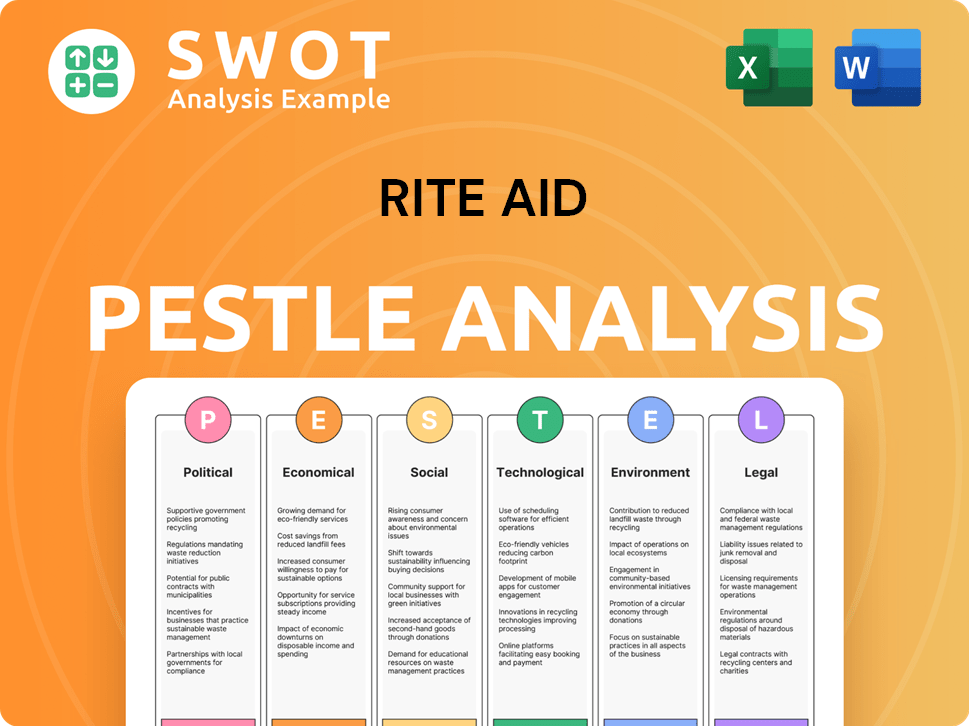
What Is Rite Aid’s Growth Forecast?
The financial outlook for Rite Aid reflects significant challenges and strategic shifts. The company's recent performance has been marked by substantial losses and ongoing restructuring efforts. A comprehensive Rite Aid company analysis reveals the complexities of its current financial state.
In fiscal year 2023, despite generating $24 billion in revenue, Rite Aid reported losses of $750 million. The first quarter of fiscal year 2024 showed a decrease in revenue to $5.65 billion from $6.01 billion in the prior year's quarter. The net loss for the first quarter of fiscal year 2024 widened to $306.7 million, a significant increase from a net loss of $110.2 million in the same period in 2022, primarily due to a goodwill impairment charge at Elixir.
The company had updated its fiscal year 2024 outlook, projecting total revenues between $22.6 billion and $23.0 billion. Adjusted EBITDA was expected to be between $330 million and $360 million, with the Retail Pharmacy Segment Adjusted EBITDA between $240 million and $260 million, and the Pharmacy Services Segment Adjusted EBITDA between $90 million and $100 million. Net loss for fiscal year 2024 was anticipated to be between approximately $650 million and $680 million.
Rite Aid emerged from its first Chapter 11 bankruptcy in September 2024, having eliminated approximately $2 billion of debt and securing $2.5 billion in exit financing. However, the company filed for Chapter 11 again in May 2025.
The second bankruptcy filing in May 2025, involved liabilities estimated between $1 billion and $10 billion. This indicates the magnitude of the financial challenges the company faces.
The second filing aims to facilitate a strategic sale process for substantially all of its assets. This is a key component of Rite Aid's turnaround strategy.
The company is supported by $1.94 billion in new financing commitments from existing lenders. This financing is crucial for supporting operations during the asset divestment process.
Rite Aid's financial narrative now centers on maximizing value through asset divestment. This is a critical element of their Rite Aid growth strategy.
The company's Rite Aid future prospects are closely tied to the success of its asset sales and restructuring. The Rite Aid market share and overall Rite Aid financial performance will be heavily influenced by these actions.
Rite Aid Business Model Canvas
- Complete 9-Block Business Model Canvas
- Effortlessly Communicate Your Business Strategy
- Investor-Ready BMC Format
- 100% Editable and Customizable
- Clear and Structured Layout
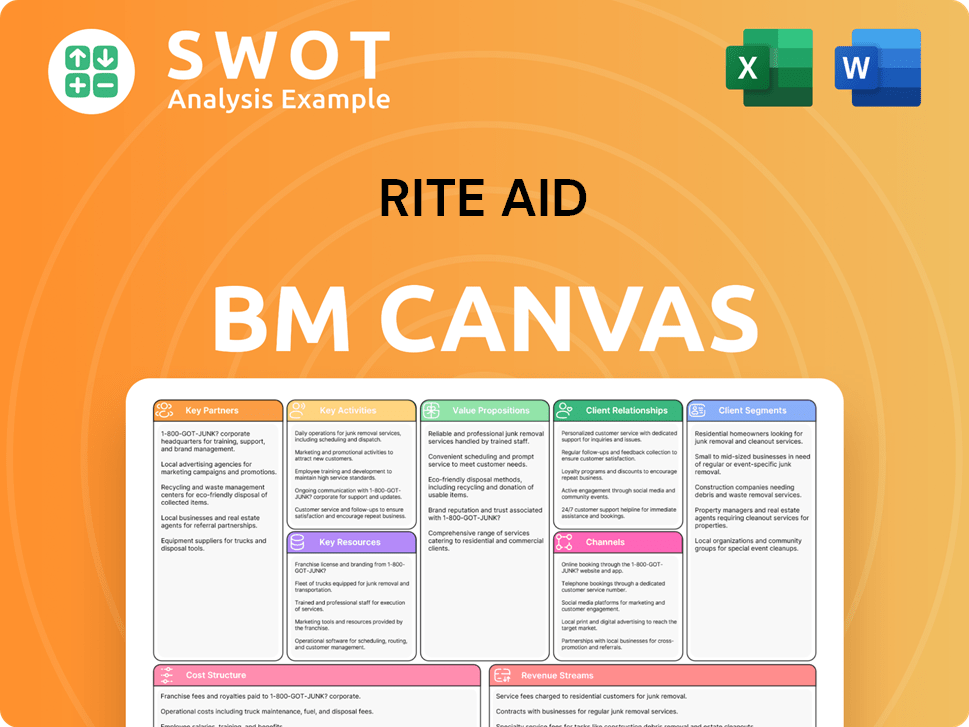
What Risks Could Slow Rite Aid’s Growth?
The challenges faced by the company are significant, casting a shadow over its potential for growth. Intense competition, regulatory pressures, and internal operational issues have created a complex environment. These factors have significantly impacted the company's ability to achieve sustainable growth.
The company's struggles extend beyond market competition, encompassing financial distress and operational inefficiencies. The company's trajectory is uncertain, with the possibility of a complete exit from the market. Understanding these risks is crucial for assessing the company's future prospects.
The intense competition from larger pharmacy chains, such as CVS and Walgreens, and mass-market retailers like Walmart and Amazon, has consistently eroded its market share and profitability, which has significantly impacted the company's Mission, Vision & Core Values of Rite Aid.
The company faces intense competition from larger pharmacy chains and mass-market retailers. These competitors often offer lower prices and a wider range of healthcare services. This competitive landscape has made it challenging for the company to maintain its market share and profitability. This is a crucial aspect of the company analysis.
Regulatory changes and legal liabilities, particularly from opioid-related lawsuits, have drained resources. These legal challenges have significantly impacted the company's financial stability. The ongoing legal battles and the associated costs pose a significant risk to the company's future.
Supply chain issues have hindered the company's ability to keep shelves stocked, leading to reduced sales. This has created a 'vicious cycle' of lower sales and tighter credit terms from vendors. The inability to maintain adequate inventory levels has directly affected the customer experience and deterred sales.
Declining consumer demand for front-end merchandise and changing consumer habits are impacting sales. Lower reimbursement rates also contribute to the financial strain. Adapting to shifting consumer preferences and maintaining profitability in a changing market is a key challenge.
The company faces challenges in hiring and retaining pharmacists and pharmacy technicians. These internal constraints compound operational difficulties and impact service quality. Addressing staffing shortages is essential for improving operational efficiency.
The company emerged from its first bankruptcy in September 2024 but has struggled to secure new financing. Persistent operational hurdles such as inflation, rising rent, and supply chain costs have led to a second bankruptcy filing in May 2025. The company's financial instability significantly impacts its long-term investment potential.
The company operates in a highly competitive market dominated by large players like CVS and Walgreens. These competitors have substantial resources and a broader range of services. The company's market share has been under pressure due to these competitive dynamics. This impacts the company's ability to execute its Rite Aid growth strategy.
The company's financial performance has been significantly impacted by legal liabilities and operational challenges. Multiple bankruptcy filings reflect the severity of its financial distress. Addressing these financial issues is critical for any potential turnaround strategy. This affects the company's Rite Aid financial performance.
Supply chain disruptions and staffing shortages have created significant operational hurdles. These issues have led to inventory shortages and reduced service quality. Improving operational efficiency is crucial for the company's turnaround strategy. These challenges directly impact the company's pharmacy services.
The company's future prospects are uncertain, with the potential for a full exit from the market. The current strategy involves asset sales and restructuring. The company's ability to navigate these challenges will determine its long-term investment potential. This uncertainty affects the company's Rite Aid stock forecast.
Rite Aid Porter's Five Forces Analysis
- Covers All 5 Competitive Forces in Detail
- Structured for Consultants, Students, and Founders
- 100% Editable in Microsoft Word & Excel
- Instant Digital Download – Use Immediately
- Compatible with Mac & PC – Fully Unlocked
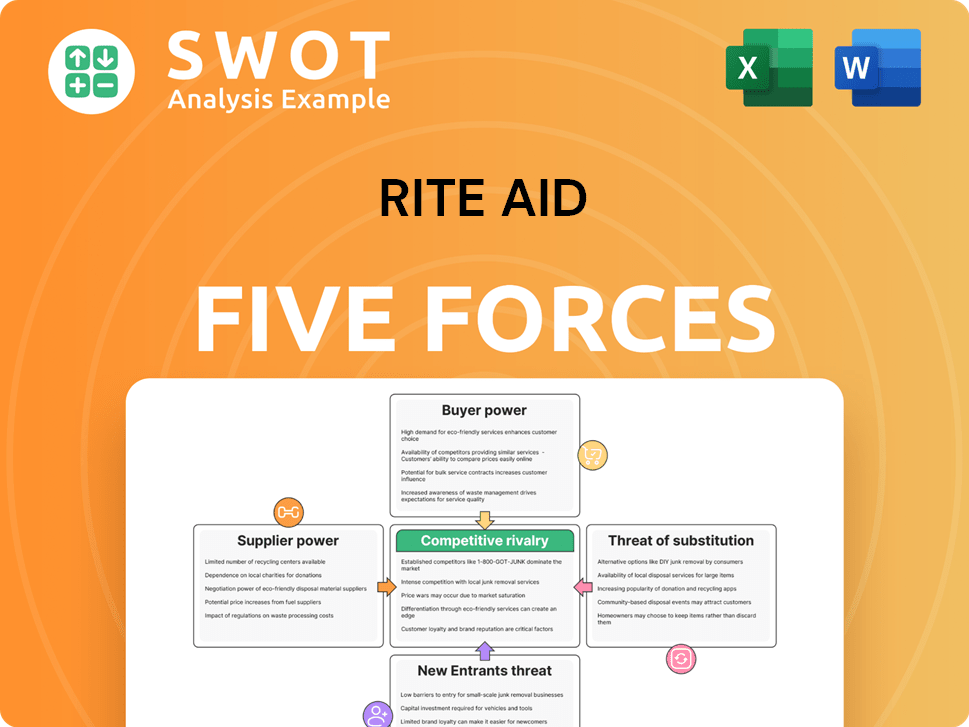
Related Blogs
- What are Mission Vision & Core Values of Rite Aid Company?
- What is Competitive Landscape of Rite Aid Company?
- How Does Rite Aid Company Work?
- What is Sales and Marketing Strategy of Rite Aid Company?
- What is Brief History of Rite Aid Company?
- Who Owns Rite Aid Company?
- What is Customer Demographics and Target Market of Rite Aid Company?
Disclaimer
All information, articles, and product details provided on this website are for general informational and educational purposes only. We do not claim any ownership over, nor do we intend to infringe upon, any trademarks, copyrights, logos, brand names, or other intellectual property mentioned or depicted on this site. Such intellectual property remains the property of its respective owners, and any references here are made solely for identification or informational purposes, without implying any affiliation, endorsement, or partnership.
We make no representations or warranties, express or implied, regarding the accuracy, completeness, or suitability of any content or products presented. Nothing on this website should be construed as legal, tax, investment, financial, medical, or other professional advice. In addition, no part of this site—including articles or product references—constitutes a solicitation, recommendation, endorsement, advertisement, or offer to buy or sell any securities, franchises, or other financial instruments, particularly in jurisdictions where such activity would be unlawful.
All content is of a general nature and may not address the specific circumstances of any individual or entity. It is not a substitute for professional advice or services. Any actions you take based on the information provided here are strictly at your own risk. You accept full responsibility for any decisions or outcomes arising from your use of this website and agree to release us from any liability in connection with your use of, or reliance upon, the content or products found herein.